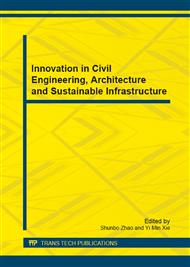[1]
L.H. Tuthill, Resistance of cement to the corrosive action of sodium sulfate solutions. ACI Journal, 33 (1936) 83-103.
Google Scholar
[2]
X. Fang, C. Shen, D. Yang, Investigations of influence factor on the rate of concrete sulfate attack, Journal of Building Materials, 10 (2007) 89-96.
Google Scholar
[3]
M. Shi, Y. Xie, B. Liu, Resistance to sulfate salt crystallization of cement pastes containing ultra-fine fly ash, Journal of Building Materials, 6 (2003) 350-355.
Google Scholar
[4]
M.T. Bassuoni, M. L. Nehdi, Durability of self-consolidating concrete to different exposure regimes of sodium sulfate attack, Materials and Structures, 42 (2009) 1039-1057.
DOI: 10.1617/s11527-008-9442-2
Google Scholar
[5]
M.T. Bassuoni, M. L. Nehdi, Durability of self-consolidating concrete to sulfate attack under combined cyclic environments and flexural loading, Cement and Concrete Research, 39 (2009) 206-226.
DOI: 10.1016/j.cemconres.2008.12.003
Google Scholar
[6]
J. A. Hartell, A. J. Boyd, C. C. Ferraro, Sulfate attack on concrete: effect of partial immersion, Journal of Materials in Civil Engineering, 23 (2011) 572-579.
DOI: 10.1061/(asce)mt.1943-5533.0000208
Google Scholar
[7]
M. Basista, W. Weglewski, Chemically assisted damage of concrete: A model of expansion under external sulfate attack. International Journal of Damage Mechanics, 18 (2009) 155-175.
DOI: 10.1177/1056789508097540
Google Scholar
[8]
A. Bonakdar, B. Mobasher, Multi-parameter study of external sulfate attack in blended cement materials, Construction and Building Materials, 24 (2010) 61-70.
DOI: 10.1016/j.conbuildmat.2009.08.009
Google Scholar
[9]
F. Girardi, W. R. Vaona, D. Maggio, Resistance of different types of concretes to cyclic sulfuric acid and sodium sulfate attack, Cement and Concrete Composites, 32 (2010) 595-602.
DOI: 10.1016/j.cemconcomp.2010.07.002
Google Scholar
[10]
M. Sahmaran, T. K. Erdem, I. O. Yaman, Sulfate resistance of plain and blended cements exposed to wetting–drying and heating-cooling environments. Construction and Building Materials. 21 ( 2007) 1771-1778.
DOI: 10.1016/j.conbuildmat.2006.05.012
Google Scholar
[11]
P. J. M. Monteiro, K. E. Kurtis, Experimental asymptotic analysis of expansion of concrete exposed to sulfate attack, ACI Materials Journal, 105 (2008) 62-71.
DOI: 10.14359/19208
Google Scholar
[12]
E. E. Hekal, E. Kishar, H. Mostafa, Magnesium sulfate attack on hardened blended cement pastes under different circumstances, Cement and Concrete Research, 32 (2002) 1421-1427.
DOI: 10.1016/s0008-8846(02)00801-3
Google Scholar
[13]
J. Skalny, J. Marchand, I. Odler, Sulfate Attack on Concrete. Spon Press, London and New York, (2002).
Google Scholar
[14]
P. K. Mehta, Sulfate attack on concrete: separating myths from reality, Concrete International, 22 (2000) 57-61.
Google Scholar
[15]
H. Haynes, R. O'Neill, P. K. Mehta, Concrete deterioration from physical attack by salts, Concrete International, 18 (1996) 63-68.
Google Scholar
[16]
W. Jin, Y. Zhao, Durability of Concrete Structures, Science Press, Beijing, (2002).
Google Scholar
[17]
ASTM C1012, Standard Test Method for Length Change of Hydraulic-cement Mortars Exposed to a Sulfate Solution. Am Soc Test Mater, (2004).
DOI: 10.1520/c1012_c1012m
Google Scholar


